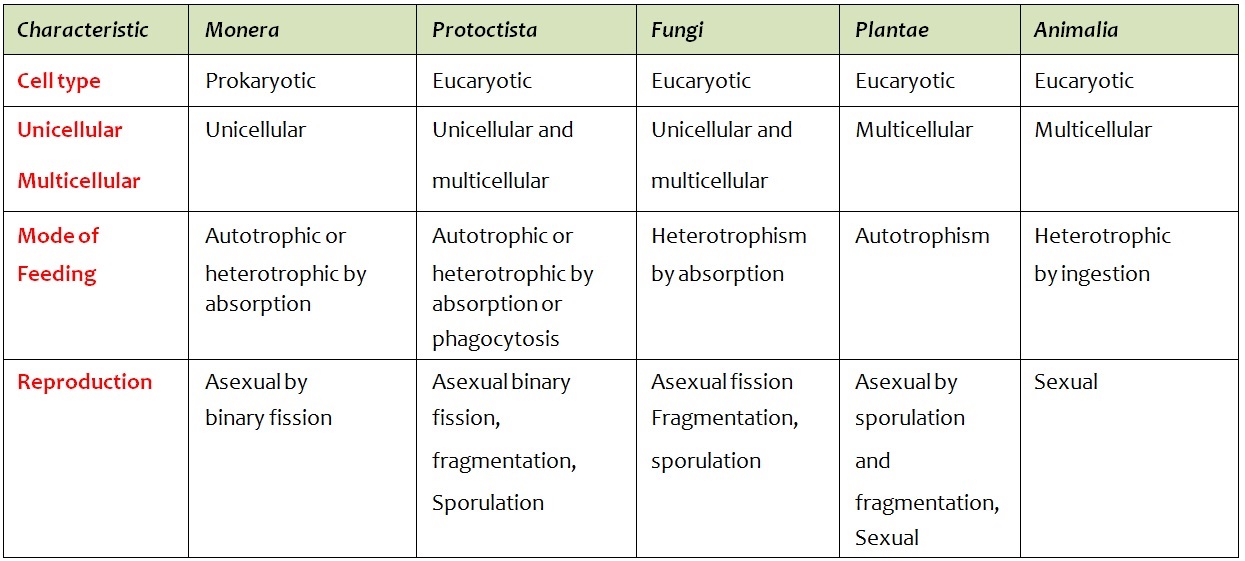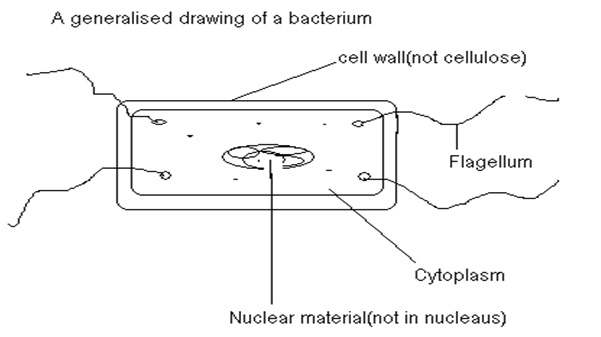General Principles of Classification
- Classification is the science that puts organisms into distinct groups to make their study easy and systematic.- Modern scientific classification is based on structure and functions.
- Organisms with similar anatomical and morphological characteristics are placed in one group while those with different structures are grouped separately.
- Modern studies in genetics and cell biochemistry are used to give additional help in classifying organisms.
- There are seven major taxonomic groups.
- The kingdom is the largest group.
- Others are phylum (division for plants) class, order, family, genus and species, the smallest.
Binomial Nomenclature
- Living organisms are named using Latin or Latinised names.
- Every organism has two names.
- This double naming is called binomial nomenclature.
- This system of naming was devised by Carolus Linnaeus in the 18th Century.
- The first name is the generic name - the name of the genus.
- The second name is the name of the species.
- The generic name starts with a capital letter while that of the species starts with a small letter.
- The names are written in italics or are underlined in manuscripts.
Examples of Binomial Nomenclature
a) Bean = Phaseolus vulgaris
- Phaseolus is the generic name
- vulgaris is the specific name.
b) Dog = Canis familiaris
- Canis is the generic name
- familiaris the specific name.
c) Human = Homo sapiens
d) Potato = Solanium tuberosum
e) Maize = Zea mays
General Characteristics of Kingdoms
- Organisms are classified into five kingdoms.
- Monera
- Protoctista
- Fungi
- Plantae
- Animalia
- Viruses do not fit neatly into any of the above kingdoms. The reasons are:
- They are simple and not cellular.
- They are metabolically inactive outside the host cell.
- Most of them can be crystallised like chemical molecules.
- Therefore they do not exhibit the characteristics of living organisms.

General characteristics of kingdom
Kingdom Monera
Characteristics of Kingdom Monera
- Unicellular and microscopic.- Some single cells, others colonial.
- Nuclear material not enclosed within nuclear membrane-prokaryotic.
- Have cell wall but not of cellulose.
- Have few organelles which are not membrane bound.
- Mitochondria absent.
- Mostly heterotrophic, feeding saprotrophically or parasitically,some are autotrophic.
- Reproduction mostly asexual through binary fission.
- Most of them are anaerobes but others are aerobes.
- Most move by flagella.

Examples of Kingdom Monera
- Examples include Escherichia coli, Vibrio cholerae and Clostridium tetani.- Spherical known as Cocci.
- Rod shaped - e.g. Clostridium tetani.
- Spiral shaped e.g. sprilla.
- Coma shaped- Vibrios -e.g., Vibrio cholerae.
Importance of Bacteria
- They are used in food processing e.g., Lactobacillus used in processing of cheese, yoghurt.- Involved in synthesis of vitamin B and K, in humans and breakdown of cellulose in herbivores.
Genetic Engineering
- Bacteria are easily cultured and are being used for making antibiotics, aminoacids and enzymes e.g. amylase, and invertase e.g., Escherichia coli.Nutrient Cycling by Bacteria
- Bacteria play an essential role of organic matter degradation in nutrient cycling- Saprophytes (Fungus) are found on dead or decaying organic matter such as decaying tree logs.
- They are involved in decomposition of dead organic matter.
- They are useful in the nitrogen cycle.
- Nitrogen fixing and nitrifying bacteria.
- They increase soil fertility.
- Modern sewage works use bacteria in treatment of sewage.
- Cleaning oil spills in oceans and lakes.
Harmful Effects of Bacteria
- Bacteria cause disease:- To humans (e.g. Cholera).
- To animals (e.g. Anthrax).
- Bacteria cause food spoilage. - Others cause food poisoning e.g. Salmonella.
- Denitrifying bacteria reduce soil fertility e.g., Pseudomonas denitrificans.
Kingdom Protoctista
Examples Kingdom Protoctista
- Algae such as spirogyra, Chlamydomonas, euglena, Sargassum.- Protozoa such as amoeba, paramecium and Trypanosoma.
General Characteristics of Kingdom Protoctista
- They are said to be eukaryotic since their nucleus is bound by a membrane.- Most are mobile, and use flagella, cilia and pseudopodia.
- Some are sessile (Plant that have no stalk. Organisms that stay in one place).
- They reproduce mainly asexually, by binary fission, fragmentation and sporulation.
- Some reproduce sexually by conjugation.
- Some are heterotrophic e.g. paramecium.
- Others are autotrophic e.g. spirogyra.
Importance of Kingdom Protoctista
- Algae are the primary producers in aquatic food chains.- They release a lot of oxygen to the atmosphere.
- Some cause human diseases like malaria and amoebic dysentery ,sleeping sickness.
- Some are source of food for humans e.g. sargassum is a source of iodine.
- Skeletons of diatoms used in paint making.
Spirogyra:
- They have spiral chloroplast.
- They are green, thread-like filaments.
Chlamydomonas:
- This is a unicellular green algae and has a cup shaped chloroplast.
- They move towards light using the flagella.
- Cilia assist the organism to move.
- The shape is due to the presence of a thin flexible pellicle.
Kingdom Fungi
- Multicellular fungi are made of thread-like structures called hyphae (singular hyphae) that form a mycelium.- e.g.Saccharomyces cereviseae(bread yeast).
- Others include Penicillium, Rhizopus, and edible mushroom.
Benefits of Fungi
- Some fungi are used as food e.g. mushrooms.
- Some are decomposers which enhance decay to improve soil fertility - recycling of nutrients e.g., toadstools.
- Some are useful in brewing and bread making e.g., yeast. Yeast is used as food - a rich source of Vitamin B.
- Some are useful in production of antibiotics e.g., Penicillium griseofulvin.
- Used in sewage treatment e.g., Fusarium spp.
Harmful Effects of Fungi
- Some cause food poisoning by producing toxic compounds e.g. Aspergillus flavus which produces aflatoxins.
- Some cause food spoilage, fabric and wood spoilage through decomposition.
- Some cause diseases to humans e.g., athlete's foot and ringworms.
- Others cause diseases to plants e.g., potato blight (Irish potatoes) rust in tomatoes and smuts in cereals.
Kingdom Plantae
Characteristics Kingdom Plantae
- They are multicellular and eukaryotic.
- They are photosynthetic and have a pigment chlorophyll.
- Their cells have cellulose cell walls.
- They reproduce sexually, others asexually.
- Kingdom Plantae has three major divisions:
Divisions of Kingdom Plantae
- Bryophyta
- Pteridophyta
- Spermatophyta
Division Bryophyta
- These include mosses and liverworts.
- Plant body is not differentiated into root, stem and leaves.
- They have simple structures which resemble leaves and stems.
- They have rhizoids for absorbing water and anchoring the plant to substratum.
- Life cycle consists of two morphologically different plants, the gametophyte and sporophyte.
- The two alternate.
- They show alternation of generations.
- The gamete producing gametophyte is the persistent plant.
- The sporophyte is attached to the gametophyte and is nutritionally dependent on it.
- They lack vascular system.
- Sexual reproduction is dependent on water.
Division Pteridophyta
- These include ferns and horsetails.
General Characteristics of Division Pteridophyta
- They have root and shoot system.
- Leaves are compound known as fronds, they have a vascular system.
- They show alternation of generations whereby the spore bearing sporophyte is the main plant.
- Spores are borne in clusters on the underside of leaves making sari.
- The gametophyte is an independent minute structure called prothallus which is short lived.
- Sexual reproduction is dependent on water.
Division Spermatophyta
- These are the seed bearing plants.
General Characteristics of Division Spermatophyta
- Plant body is differentiated into root, stem and leaves.
- Vascular tissue consists of xylem and phloem.
- Sexual reproduction is independent of water.
- Male gametophyte (pollen grain) germinates and grows to reach female gametophyte.
- They are divided into two sub-divisions:
- Gymnosperms
- Angiosperms
1. Gymnosperms
- These are cone-bearing plants.
- Naked seeds.
- They are trees and shrubs.
- Xylem consists of tracheids only.
- Examples; pine, cypress and spruce.
- They show xerophytic characteristics like having needle-like leaves.
2. Angiosperms
- Seeds are enclosed within a fruit.
- They comprise trees, shrubs and herbs.
- Xylem consists of vessels of tracheids.
- These are the most advanced plants.
- Angiosperms has two classes;
- Monocotyledonae
- Dicotyledonae
Dicotyledonae vs Monocotyledonae
| Dicotyledonae | Monocotyledonae |
|---|---|
| Embryo has two cotyledons | Embryo has one cotyledon |
| Leaves are broad and have network of veins | Leaves are long with parallel veins (have leaf sheath) |
| Transverse section of root has no pith | Transverse section of root has pith |
| Have tap root system | Have fibrous root system |
| Cross section of stem reveals vascular bundles arranged in a ring. | Cross section of stem reveals vascular bundles scattered all over. |
| Vascular cambium present and have secondary growth. | Vascular cambium absent and do not have secondary growth. |
| Flower parts in four, five or multiples of these | Flower parts in four, five or multiples of these |
| Examples: herbs e.g. tomato; shrubs e.g. tea, hibiscus, lantana. | Examples: grass, wheat, sugar-cane. |
Importance of Spermatophyta
- They are a source of food for humans and other animals.- Source of fue1- wood fuel and charcoal.
- Source of timber for building and for paper.
- Ornamental plants.
- Useful in textile industry.
